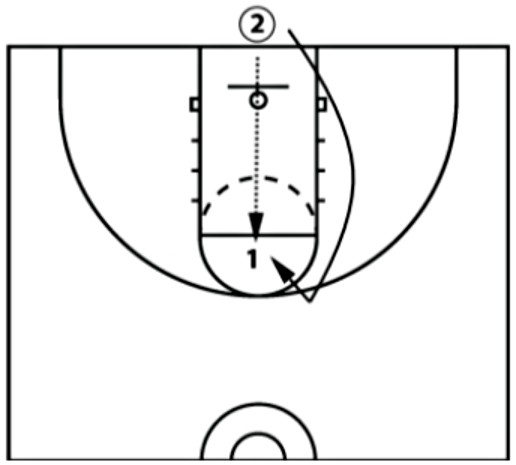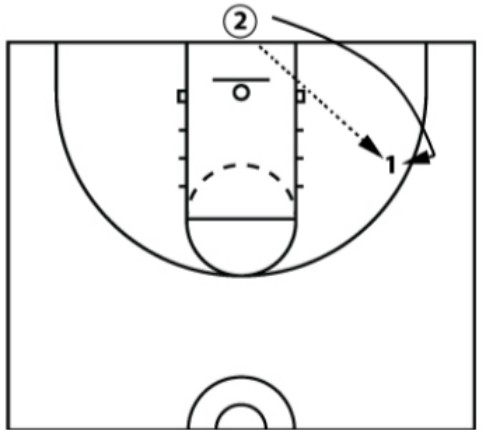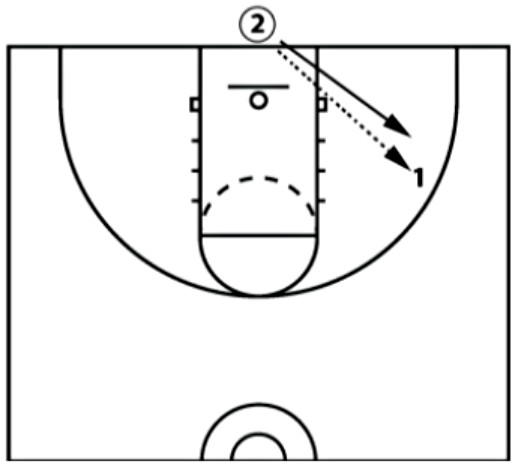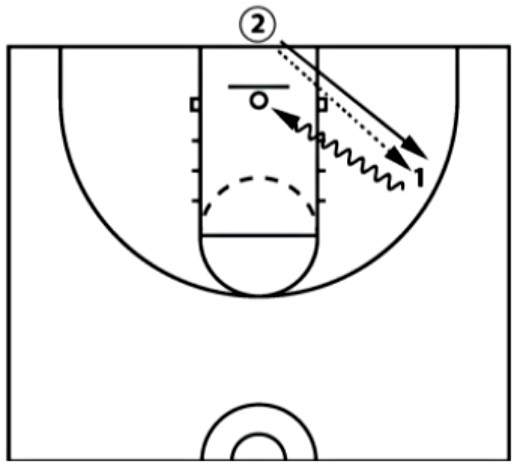5 Partner Shooting Drills - Beginner to Advanced Progressions for Basketball Players
These shooting drill progressions will speed up the development of your shot and correlate to better shooting
during games. You can use these progressions as a template for improving other skills as well.
Shooting Drill Progression #1: Partner Shooting - Quick Release
Here we will learn how to isolate the shooting skill and get a bunch of reps in a short amount of time. This is important when we are first practicing a skill or learning a new skill. You will see pro players do the same thing to develop rhythm and confidence prior to working out or playing a game.
In this particular drill, you're focusing on developing a quicker shot release.
Instructions:

One player starts at the free throw line in a shooting position.
Player 2 begins with the ball at the baseline.
Player 2 makes the pass to the player 1 at the free throw line.
To get both players involved, you follow your shot and the passer (Player 2) runs to the free throw line to take the next shot.
The pattern continues.
Training Tips:
- Create Target with Hands - Your hands should create a target for the passer. This helps with better passes and helps speed up the shot.
- Feet Aligned - You want your feet aligned to the basket. You should act as if you already have the ball in your hands so you are ready to quickly shoot the ball.
- Legs Loaded - Legs are loaded so when you catch the ball, you are ready to immediately shoot the ball.
Shooting Drill Progression #2 - Partner Shooting - Change Spots
In the next progression, you add a little variability to the drill by having the shooter move to a new spot after
each spot. At first this may cause you to shoot a lower percentage, however, it does speed up the learning and ability
to retain the new skill, which will lead to better shooting in the long run.
Instructions:

This is very similar to the last drill. The only difference is that you change the position on each shot.
One player starts at any spot on the floor.
Player 2 begins with the ball at the baseline.
Player 2 makes the pass to the player 1. Player 1 immediately shoots.
To get both players involved, you follow your shot and the passer (Player 2) runs to the free throw line to take the next shot.
The pattern continues.
Training Tips:
- Spin Outs for Shooting Alone - If you don't have a partner, you can do this by spinning the ball to yourself, catching and shooting.
- Change Distance - In addition to changing the angle, you can also vary the distance of your shot each time. This is another way to challenge yourself and get better at shooting during games where the shot distance and location often varies on each repetition.
Shooting Drill Progression #3 - Partner Shooting - Soft & Hard Close Outs with Reference Defense
The next progression gets you accustomed to shooting with a defender closing out. This is vital if you want to
be a better shooter during games. You have to get better at shooting with a defender in close proximity. You also
have to get better at making the choice at attacking the basket if the defender is too close.
Instructions:

The defense closes out hard or closes out soft. You work one option for multiple reps before moving to the next one.
The rotation is the same as the previous drills.
Player 2 begins with the ball at the baseline.
Player 2 makes the pass to the player 1. Player 1 immediately shoots.
To get both players involved, you follow your shot and the passer (Player 2) runs to the free throw line to take the next shot.
The pattern continues.

Against a soft close out:
A soft close out is typically more than an arm's length away or the defender's hands are down.
Against a soft close out, you catch and shoot.
Against a hard close out:
Against a hard close out, is typically an arm's length with the defender's hands up to contest or block the shot.
Against a hard close out, you immediately attack the basket.
Training Tips:
- Attack Immediately - No Hesitation - The most important thing here is for the shooter to be assertive and aggressive. With time and repetition, your decision making will get better and will lead to more scoring.
Shooting Drill Progression #4 - Partner Shooting - Reference Defense Chooses Soft or Hard Close Out
In the next progression, you can have the defender mix up the looks between a soft close out and a hard close out. The offensive player will not know ahead of time whether it is a hard or soft close out.
This is a great drill for getting you used to game situations, and getting you used to attacking the defense.
It's the same set up and pattern as the previous three drill progressions. Passer passes to the shooter and closes out. Shooter shoots then gets the rebound and becomes passer.
Shooting Drill Progression #5 - Partner Shooting - 1v1 Close Outs to 3v3 Close Outs
Lastly, you can have the players start in the same positions, but then play live once the ball is passed.
You can play mini games to 2 or 3 points. Shooting against a live defense adds a layer to your practice and also leads to improved performance during games.
You can take this same 1-on-1 drill and add two offensive players and two defensive players to make it a 3-on-3 game. This will help players learn to pass, shoot and space within a game context
Template for Skill Development:
It was mentioned earlier that this could be used as a template for skill development. Here's a quick summary.
Progression 1 - Block Practice: In the first progression, the focus is on one skill (block practice). In the first example, the focus is on developing a quick release. The sequence is the same every time. There is no variability. The shot is taken from the same location every time. This is helpful when first learning or trying to improve a certain skill set. It's also good for warming up, developing rhythm, and working on confidence.
Progression 2 - Block, Variable Practice: In the second progression, the focus is still on one skill (block practice). However, a variable practice component has been added. This is simply done by changing the location of each shot. Adding variability has been shown to improve learning and retention of skills.
Progression 3 - Adding Defense: In the third progression, a defender is added. While you are still isolating a skill for a number of repetitions, it is important to get accustomed to dribbling, shooting, etc. with a defender present. Shooting with a defender in close proximity is a skill that needs to be practiced.
Progression 4 - Random Practice / Defense Dictates: In the fourth progression, you start to add elements of random practice. That means the sequence is unpredictable, each repetition can be different, and you're working on multiple skills.
The shooter doesn't know if the defense is going to do a soft close out or a hard close out. So this makes each repetition different and the sequence unpredictable for the shooter. Now, you are also mixing skills (interleaving practice) when you choose to shoot or dribble attack.
Progression 5 - Random Practice / Live Defense: In the next progression, the defense is live and you're playing 1v1. This is very important as you need to practice and make decisions against a live defense. This is how we play the game!
And if you have enough players, layering 2v2 and 3v3 onto this same drill allows you to practice the skills of passing, when to pass, and moving without the ball. This makes the drill very game-like.
Learn More About Block, Variable, Serial, and Random Practice:
If you want to learn why these progressions will speed up skill development, and lead to better game performance, you can look into the research on block practice, variable practice, serial practice and random practice. Here are a couple of articles that we wrote as well.
Block, Serial, & Random Practice
Constant Vs. Variable Practice - Shoot Worse in Practice to Shoot Better in Games
Related Resources:
Breakthrough Basketball Shooting Camps
Breakthrough Basketball Camps - Search By State, Age, Month
Free Guide and Shooting Workouts
What do you think? Let us know by leaving your comments, suggestions, and questions...
|
|||||



 Facebook (145k Followers)
Facebook (145k Followers) YouTube (152k Subscribers)
YouTube (152k Subscribers) Twitter (33k Followers)
Twitter (33k Followers) Q&A Forum
Q&A Forum Podcasts
Podcasts